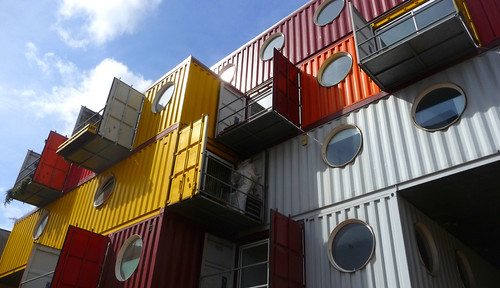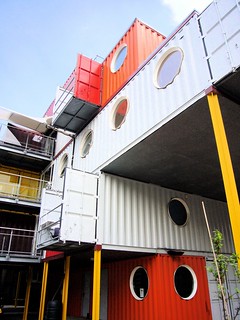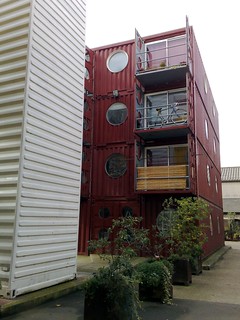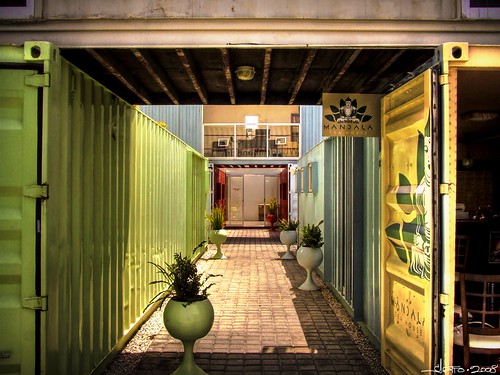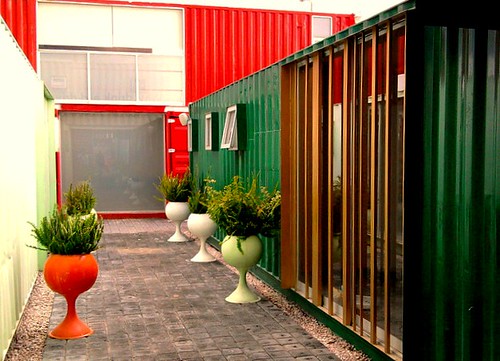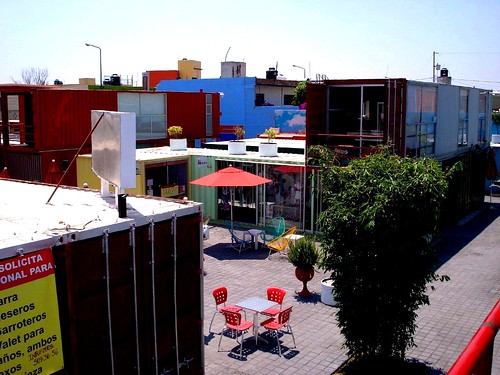Shipping container "cities" bring creative, funky approach to green construction

Posted May 11, 2012 at 1:28PM
This started out as an article on prefabricated modular housing, which can bring the construction price of new homes down considerably and lends itself well to use of green materials and straightforward replication. There’s a multi-part series on green prefab construction, including the history and evolution of the industry, on the always-fascinating Inhabitat site.
I knew from previous articles that I wanted to make container homes, or living quarters fashioned from recycled standard freight shipping containers, part of the story. They take recycling to a new level. But in the course of researching photos of container homes, I ran across something even more fascinating: large, colorful, multi-family “cities” of work spaces and homes built from shipping containers in London, Mexico, Amsterdam and, perhaps soon, New York.
The most well-known of these is London’s Container City, on the Thames at Trinity Buoy Wharf, across the river from the O2 Arena. Here’s how Inhabitat writer Jorge Chapa described the project in 2007:
“The London docklands development is composed of environmentally friendly work studios and live/work lofts stacked on top of each other to create a 5-story building. What’s particularly interesting about Container City is its scale and flexibility. Architect Nicholas Lacey and Buro Happold created a flexible design system that relies on component pieces instead of units. Instead of using a 1 container = 1 unit approach, their system relies on components in various permutations to create very livable, adaptable spaces. Aside from this Container City residential project, the system has been used in projects as diverse as classrooms, office spaces, residential units, retail spaces and even youth centres.
“Containers as architecture are just one of the ways in which we can look at objects and find new uses to them. The modular nature of the containers, their adaptability, and the fact that they can be found in industrial surplus make them an ideal prefab material.”
The first phase of the project (“Container City I”), containing twelve work studios, “was installed in 2001, in 4 days, and fitted out over 5 months,” according to a Wikipedia entry. 22 more studios were added the following year. Since then the London-based firm Urban Space Management, which developed the project, has marketed the Container City brand as a system of modular construction that uses shipping containers to create affordable accommodation for a range of uses. The website lists 20 container projects, mostly in the UK, either completed or in development. USM’s Eric Reynolds believes the method is ideally suited for the construction of affordable homes on sites too small to justify new-build projects but where modular homes would be cost-efficient.
But, of the projects I have come across so far, my favorite may be the Container City in Cholula, about two hours southeast of Mexico City. There, the brightly painted units are placed around courtyards laid with pavers, creating a more sophisticated look for a unified pocket of walkable urbanism. It's apparently become a trendy place to go. Nicholas Gill writes in The Wall Street Journal:
“In the San Andrés district of the town of Cholula, in the shadow of Tlachihualtepetl pyramid, a group of young entrepreneurs has been channeling Brooklyn. Their 54,000-square-foot Container City is built from recycled shipping boxes, brightly painted and stacked. The creatively inclined have set up design studios in the containers, as well as tattoo parlors, cafes, vintage clothing shops, sushi bars and farm-to-table taquerias. There's live entertainment almost every night, including top deejays from Mexico City at Taxi Cerveceria, which fills up with students from the nearby Universidad de las Américas Puebla.”
The photos look fantastic.
(The Mexican project appears unrelated to Urban Space Management. Both USM and the Mexico-based developers claim a trademark for the phrase "Container City.")
USM’s website indicates that the firm and an American partner “have designed” 15 retail and residential spaces to be situated on Lafayette Street the heart of New York. The project doesn’t appear to be bustling, as far as I can tell. New York already hosts at least one project constructed of shipping containers, though, Brooklyn’s Dekalb Market, which in some ways appears to be a more informal (and perhaps temporary) cousin to the Cholula development. As of last fall the market hosted 22 vendors, including Cheeky’s New Orleans-style sandos, YakBlak’s retro shades, Sour Puss Pickles, Joe the Art of Coffee, and a vegetable garden planted by community organizations.
Here’s an entertaining video on the Container City at Trinity Buoy Wharf:
Related posts:
- Recycled land and shipping containers make a lively city market (August 8, 2011)
- Do-It-Yourself streets & neighborhood makeover in London (June 1, 2011)
- A living wall in London (May 10, 2011)
- Denver’s Aria raises the bar for smart, sustainable neighborhoods – with prefab construction! (August 25, 2009)
- Creative resourcefulness: Kansas City's "Container Home" (March 12, 2009)
Move your cursor over the images for credit information.
Please also visit NRDC’s Sustainable Communities Video Channel.
